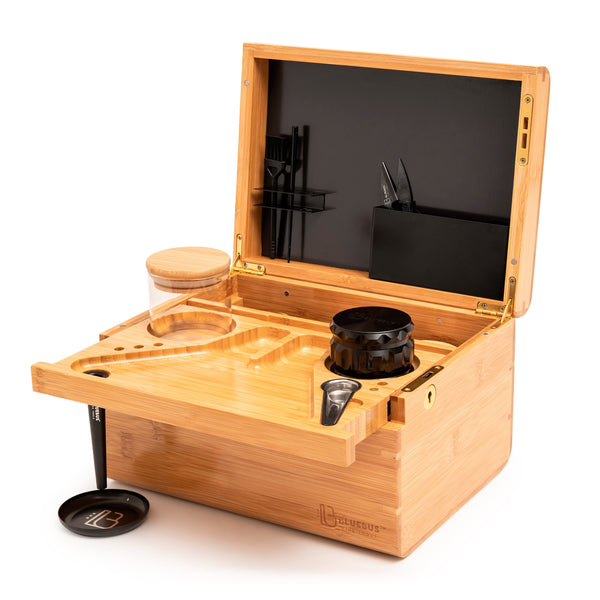What is Pipe Weed in Lord of the Rings? Exploring the Origins and Effects of Halflings' Leaf and the Answer to the Question, What is Pipe Weed Lotr

Are you curious about what pipe weed is in the Lord of the Rings? You might wonder if it's similar to tobacco or something else. Pipe-weed is a famous herb in Middle-earth, especially among hobbits.
It's grown in the Shire, showing up often in J.R.R. Tolkien’s stories. This blog will take you through its origins, effects, and how it mirrors hobbit culture.
Pipe-weed is actually tobacco, not marijuana as some fans think. This fact clears up a lot of confusion and sets the stage for exploring more about this intriguing plant from Tolkien’s universe.
Our article will help you understand why hobbits love their pipe-weed and how it became such an important part of their lives. Get ready to learn all about Halflings’ Leaf!
Key Takeaways
- Pipe-weed, known as Halflings' Leaf among other names, is a tobacco-like herb grown and loved by hobbits in the Lord of the Rings. It's mainly cultivated in Southfarthing of the Shire.
- Despite some fans thinking it might be similar to marijuana, J.R.R. Tolkien confirmed that pipe - weed is actually a type of tobacco. This clears up any confusion and highlights its importance in hobbit culture.
- The growing and smoking of pipe - weed are key traditions for hobbits, reflecting their strong connection to nature and love for agricultural practices. These traditions also play a big role in social gatherings, fostering camaraderie among them.
- Hobbits enjoy different strains of pipe - weed such as Old Toby and Longbottom Leaf for their unique flavors. This variety adds depth to their community's lifestyle and showcases their appreciation for fine tobacco leaves.
- The use of pipe-weed has sparked controversy regarding its effects and comparisons to real-world substances like cannabis. However, within Middle-earth, it remains a beloved pastime that mirrors the leisurely pace and rich social life of hobbit society.
What is Pipe-Weed in Lord of the Rings?
Exploring the origins and effects of halflings' leaf in the world of Middle-earth, pipe-weed is a herbal smoking blend enjoyed by characters in J.R.R Tolkien's works. The appearance, usage, and influence of this unique substance are intriguing facets to delve into.
Origin and development
Pipe-weed, known for its popularity among Hobbits in the Lord of the Rings universe, finds its roots deep within the fertile grounds of the Shire, specifically Southfarthing. This special herb, embraced by characters like Gandalf and Frodo with great enthusiasm, reflects a tradition of cultivation and enjoyment that spans generations in Middleearth.
The art of growing and harvesting pipe-weed plays a pivotal role in hobbit culture, showcasing their deep connection to nature and agricultural prowess.
This beloved leaf goes by many names including Halflings' Leaf, Old Toby, and Longbottom Leaf - each variant presenting a unique blend or quality revered by smokers across Middleearth.
Noteworthy is the contrast between premium strains like Old Toby or Longbottom Leaf versus Southlinch from Bree – which signifies varying degrees of appreciation among enthusiasts.
The intricate process from seed to smoke involves careful selection, planting, nurturing, and finally drying before it can fill the bowls of clay or wooden pipes used widely in Tolkien’s works.
Through this meticulous craftmanship emerges an emblematic pastime shared amongst friends and folk in taverns or under open skies.
Appearance and usage
Pipe-weed, also known as Halflings' Leaf, is a popular herb enjoyed by the hobbits in the Lord of the Rings universe. It is often seen being smoked in pipes made of clay or wood. The pipe-weed itself is grown mainly in the Shire, particularly in Southfarthing.
Notably, it goes by different names such as Old Toby and Longbottom Leaf among others. The quality of pipe-weed can vary; for instance, there's a lower-quality strain called Southlinch that's used in Bree.
Hobbits are frequently depicted engaging with pipe-weed throughout the series, showcasing its significant role in their culture. Moreover, it's worth noting that J.R.R. Tolkien confirmed that this herbal delight is actually tobacco and not cannabis despite speculation to the contrary within fan discussions and articles exploring its origins and effects.
Different names used
In the world of the Lord of the Rings, pipe-weed is known by various names. Some of these include Halflings' Leaf, Old Toby, and Longbottom Leaf. Additionally, a lower quality strain called Southlinch is used in Bree.
This diversity in nomenclature reflects the regional differences in cultivation and use within Middle-earth. The names given to this popular herb highlight its significance and widespread enjoyment among hobbits, adding depth to their culture in J.R.R.
Tolkien's fantasy universe.
The Effects and Influence of Pipe-Weed
Pipe-Weed, in the Lord of the Rings, holds similarities to tobacco and has sparked controversy surrounding its use. Its effects and influence mirror those of tobacco.
Similarities to tobacco
Pipe-weed shares many similarities with tobacco. It is grown, harvested, and prepared in a manner reminiscent of traditional tobacco cultivation. The herb is then commonly used for smoking purposes using various types of pipes - much like the way tobacco is enjoyed.
Moreover, the controversies surrounding its use draw parallels to those associated with tobacco consumption such as debates about addiction and health implications.
The name variations also mirror the diverse range of terms used to describe different forms and varieties of tobacco products. Notably, although there have been debates speculating that pipe-weed might be similar to marijuana, J.R.R.
Controversy surrounding its use
While the pipe-weed in Lord of the Rings is confirmed to be tobacco by J.R.R. Tolkien, some fans still speculate about its nature and effects, drawing comparisons to cannabis. The controversy arises from conflicting interpretations of its portrayal in the novels and differing opinions on whether it has similarities to marijuana or if it is purely a fictional variety of tobacco.
This ongoing debate has sparked discussions among fans regarding the true nature and potential influence of pipe-weed within the context of the series.
The use of pipe-weed has become a topic of interest due to its association with counterculture and recreational smoking habits depicted in Lord of the Rings. Some readers have raised questions about how this portrayal aligns with the overall themes presented in the series, while others appreciate it as an integral part of hobbit culture.
Such controversies around its use continue to fuel conversations and debates within fan communities, adding an extra layer of complexity to understanding this beloved element in J.R.R.
Pipe-Weed as a Reflection of Hobbit Culture
Pipe-Weed reflects Hobbit culture through its strong association with food, drink, and social gatherings. It underpins the relaxed and convivial nature of Hobbit life.
Relationship with food and drink
Hobbits have a deep-rooted relationship with food and drink, forming an integral part of their culture. They take pleasure in simple yet hearty meals, often complemented by a pipe filled with the finest Longbottom Leaf or Old Toby.
The act of smoking pipe-weed is intertwined with their enjoyment of culinary delights, enhancing the flavors and aromas while fostering convivial conversations among friends.
The connection between pipe-weed and hobbits' predilection for good food and company is unmistakable. Whether it's savoring a second breakfast or relishing a long, leisurely supper, the presence of pipe-weed further enriches these moments.
Social interactions and customs
Hobbits often gather for leisurely social interactions, where the aroma of pipe-weed fills the air. Folks come together around a crackling fire, puffing on their pipes, sharing stories and laughter.
The art of smoking pipe-weed is a cherished custom among hobbits, fostering camaraderie and relaxation within their community.
In addition to casual gatherings, special occasions in the Shire are marked by the exchange of fine varieties of pipe-weed. Festivities such as birthdays or weddings are celebrated with indulgent feasts where guests can sample different blends of tobacco leaves.
Pipe-weed plays an integral role in shaping hobbit social customs and strengthening bonds among friends and family.
Conclusion
In conclusion, pipe-weed is a popular herb in the Lord of the Rings universe, enjoyed particularly by the hobbits. It is often smoked in clay or wooden pipes and grown in the Shire, with different names such as Halflings' Leaf, Old Toby, and Longbottom Leaf.
Despite speculation about its nature resembling marijuana, J.R.R. Tolkien confirmed it as tobacco. The origins and effects of pipe-weed are significantly explored among fans but remain an integral part of hobbit culture in the series.
FAQs
1. What is Pipe Weed in "Lord of the Rings"?
Pipe Weed in "Lord of the Rings" is a special tobacco that characters, especially hobbits, enjoy smoking in pipes. JRR Tolkien describes it as a leaf from the Halflings' land.
2. How do characters use Pipe Weed?
Characters in "Lord of the Rings" inhale Pipe Weed by packing it into smoking pipes and lighting it. They often imbibe it for relaxation and social gatherings.
3. Does Pipe Weed cause nicotine addiction like regular tobacco?
While JRR Tolkien doesn't specifically talk about nicotine addiction with Pipe Weed, it's similar to real-world pipe tobacco, which can lead to addiction.
4. Why did Tolkien include Pipe Weed in his books?
Tolkien included Pipe Weed in his literature to add depth to the Lord of the Rings trilogy’s world, showing cultural practices and leisure activities among different races, such as hobbits enjoying their Halflings' Leaf.






![Pipe by Vessel [Gunmetal] - Headshop.com](http://www.headshop.com/cdn/shop/files/76cd9387-8d22-4015-bd12-46bbbcef263a_{width}x.jpg?v=1682452995)
![Pipe by Vessel [Gunmetal] - Headshop.com](http://www.headshop.com/cdn/shop/files/57468aee-c849-45b9-9000-ec1eaa3e3910_{width}x.jpg?v=1682452997)






![Vessel - Mill [Beechwood]](http://www.headshop.com/cdn/shop/products/57fb9a30-819b-464a-ac67-1e8561d3bb3e.jpg?v=1679517075&width=600)
![Vessel - Air [Jade]](http://www.headshop.com/cdn/shop/products/7cd436a1-b1f0-4e01-9e52-050ad7140b56.png?v=1679506090&width=600)
![Pipe by Vessel [Rose Gold]](http://www.headshop.com/cdn/shop/files/a9e8a97e-590b-49e9-9744-6b1b900f87f4.jpg?v=1682452956&width=600)
![Vessel - Cone [Onyx]](http://www.headshop.com/cdn/shop/products/6f51074a-2173-4ab4-876d-22a84764eb5d.png?v=1679517316&width=600)

![Vessel Ash [Black] Ultimate Ashtray and Storage - Headshop.com](http://www.headshop.com/cdn/shop/files/c2410e0d-a3e9-48ea-99bf-f3b0d0d023b6_{width}x.jpg?v=1725551152)
![Vessel Ash [Black] Ultimate Ashtray and Storage - Headshop.com](http://www.headshop.com/cdn/shop/files/96564644-3a7c-45a0-beee-502ebff25cd9_{width}x.jpg?v=1725551144)
![Pipe by Vessel [Gunmetal]](http://www.headshop.com/cdn/shop/files/76cd9387-8d22-4015-bd12-46bbbcef263a.jpg?v=1682452995&width=600)






